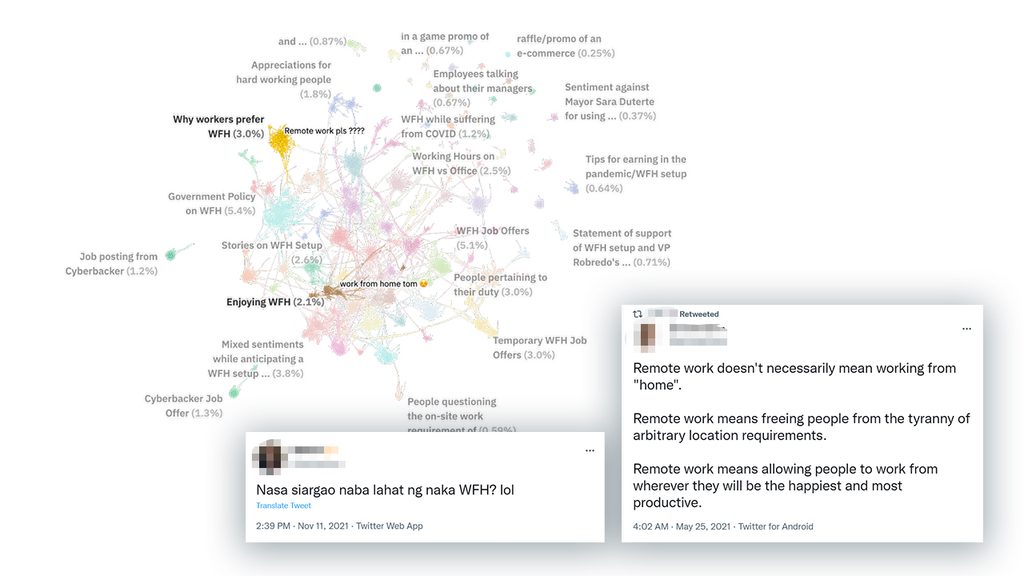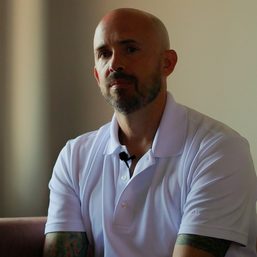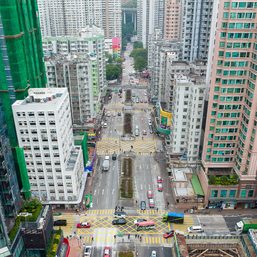SUMMARY
This is AI generated summarization, which may have errors. For context, always refer to the full article.

Editor’s note: This article is a collaboration between TheNerve, a data consultancy company, and Rappler. The tweets scanned for this data story are publicly available. Usernames were also concealed to protect the identities of the Twitter users.
When the Philippines hastily transitioned into a work-from-home (WFH) setup as an unprecedented health crisis hit the world, workers had no choice but to cope and adapt. But as soon as Filipinos started to get the hang of WFH, eased restrictions and new protocols allowed more movement and again forced Filipino workers to adjust.
With this whiplash of situations going on, what setup is truly preferred by the Filipino workforce? To answer this, TheNerve deep-dived into Filipinos’ sentiments on Twitter and analyzed their raw and unfiltered thoughts about each setup.
Looking into the timeline of conversations about WFH and return-to-office (RTO) over the past year, both topics peaked in March 2022 when companies started to require RTO. Interestingly, positive sentiments about WFH had the highest peak during this period while tweets about problems with WFH dropped. If we only look at this alone, we would think that the answer is they prefer working from home. But we all know that there is more to the story, and the data can tell us that.

‘Buti na lang WFH’
24% of the tweets scanned were all positive sentiments about WFH, and 2.2% were expressing relief because they were working from home. Buti na lang WFH (I’m glad we’re working from home) because multitasking has become possible. Filipinos have been accomplishing all the work that typically couldn’t be finished in a day, all while enjoying being in the comfort of their own homes.
Working from home undeniably has its perks and the following clusters of conversations revealed the most common ones Filipinos enjoyed.

One of the most obvious perks is that people gained more control over their time and schedules, which a significant cluster of tweets can validate. A pre-pandemic study in 2019 revealed that Metro Manila has the 2nd worst traffic in the world. The WFH setup has allowed Filipino workers to allocate the time that they would have spent in heavy traffic and grueling commutes doing other things like sleeping, bonding with the family, or pursuing hobbies.
A soon-to-be mom tweeted that she wishes she could work remotely after giving birth so she could spend more than just 90 days of maternity leave with her newborn.
WFH became work from anywhere

We’ve seen Filipinos starting to explore working from anywhere and not just from home throughout the last couple of years, fully embracing the remote work life. Aside from workers being able to go back to their home province, traveling is also one thing that they gained more time for. Some Filipinos have tried working from the sandy beaches of Boracay and Siargao, for example. These nomads say that remote work inspires them to be more productive, especially those who hold creative jobs.

Remote work also didn’t stop Filipinos from listening to music. In fact, they listened to more of it. Pre-pandemic, workers typically listened to music while in transit or while doing things outside of work like working out or running errands. But with remote work giving people more personal space and with it a license to not consider the musical tastes of those around them, they blasted music to their heart’s content.
Filipinos also willingly shared what they listen to while working, accounting for 2.2% of the conversations. Fandoms of certain K-pop artists and Pinoy pop group SB19 have grown because of this.
Aside from listening to more music, Filipinos also explored other interests while working from home like designing their desk spaces or learning about cryptocurrencies.
Time a double-edged sword

However, along with the positive sentiments were tweets expressing discomfort about the WFH setup. They make up 19% of the conversations – not that far from the percentage of positive sentiments. What some consider as a pro of WFH – more control over one’s time – was a con for some.
The time they gained from the lack of outdoor activities broke the barrier between work and personal life. Meetings are being scheduled beyond work hours and more tasks are being added to their plate because they have “more time” on their hands. Suspension of work during natural calamities is now a thing of the past – maybe unless your internet connection is affected – because “people are just at home anyway.”

But being at home doesn’t mean employees aren’t struggling. Working at home means Filipinos have to endure the hot weather, deal with internet connectivity issues, household responsibilities, and all sorts of noise daily. Those who experienced these reported stunted productivity instead of a boosted one.
These struggles are the main reasons why some employees want to go back to the office. At least in the office, you can turn on the air conditioner and not worry about this month’s electricity bills, you have high-speed internet, and you are in a place that is conducive for productive work.
Perfect setup doesn’t exist – yet
Not every Filipino can say “buti na lang WFH” (I’m glad we’re working from home) because not everyone is glad about it. On the other hand, not everyone is also too happy about returning to the office. While some Filipino workers can’t wait to enjoy the privileges of being in the office, some are not looking forward to experiencing this side of the pre-pandemic life. Time spent in transit, greater expenses – gas, fare, food – and the risk of getting COVID-19 are among the issues that workers will face as they go back to working on site.
Both sides have their pros and cons, and there was no strong preference for one over the other. It is then not a matter of this versus that but rather finding the perfect balance between both setups. To fully support Filipino workers, their companies, the government, and private sectors have to work together to implement regulations and better systems that could address the problems experienced in both.
If it took a pandemic to make them realize that it’s possible to work from home, it makes you wonder what it will take for them to make the best of both working worlds work. – Rappler.com
Frances Monsada is a Brand Strategist from TheNerve, a data consultancy company that turns data into actionable insights for content and communities. Bien Aculan is a Data Analyst from Rappler, and is currently finishing his MSc in Applied Mathematics, focusing on topology and data.
Add a comment
How does this make you feel?





![[OPINION] In a changing climate, how do we ensure safety and health at work?](https://www.rappler.com/tachyon/2024/04/Climate-change-safety-workers-April-25-2024.jpg?resize=257%2C257&crop_strategy=attention)




There are no comments yet. Add your comment to start the conversation.